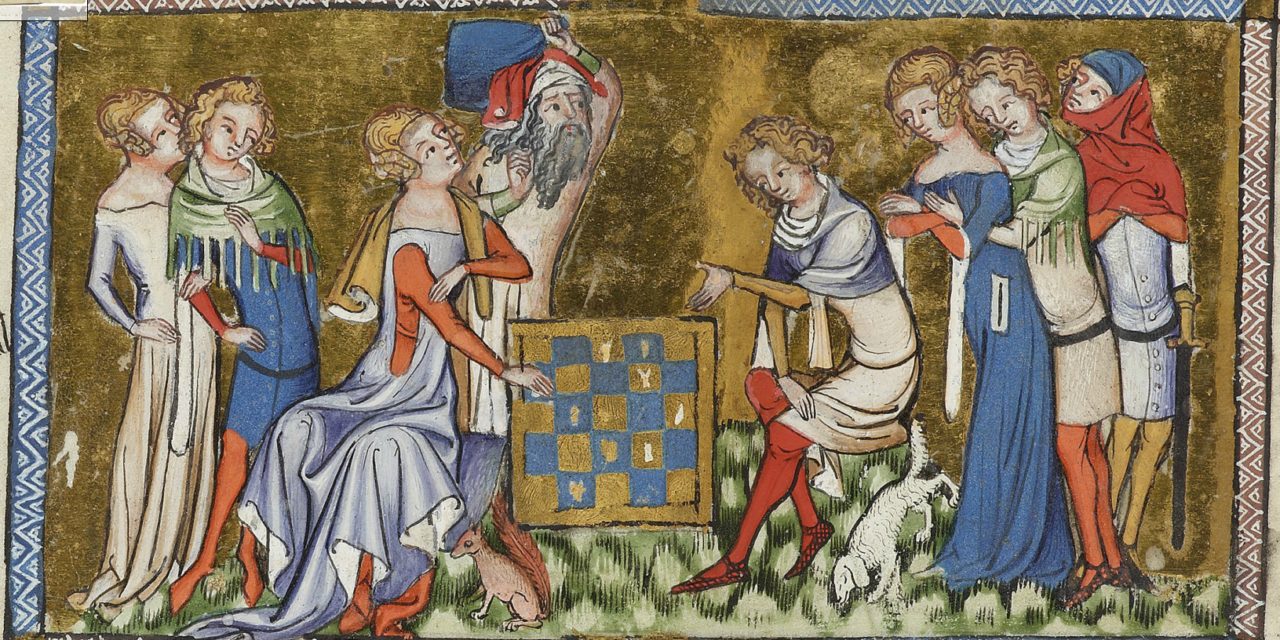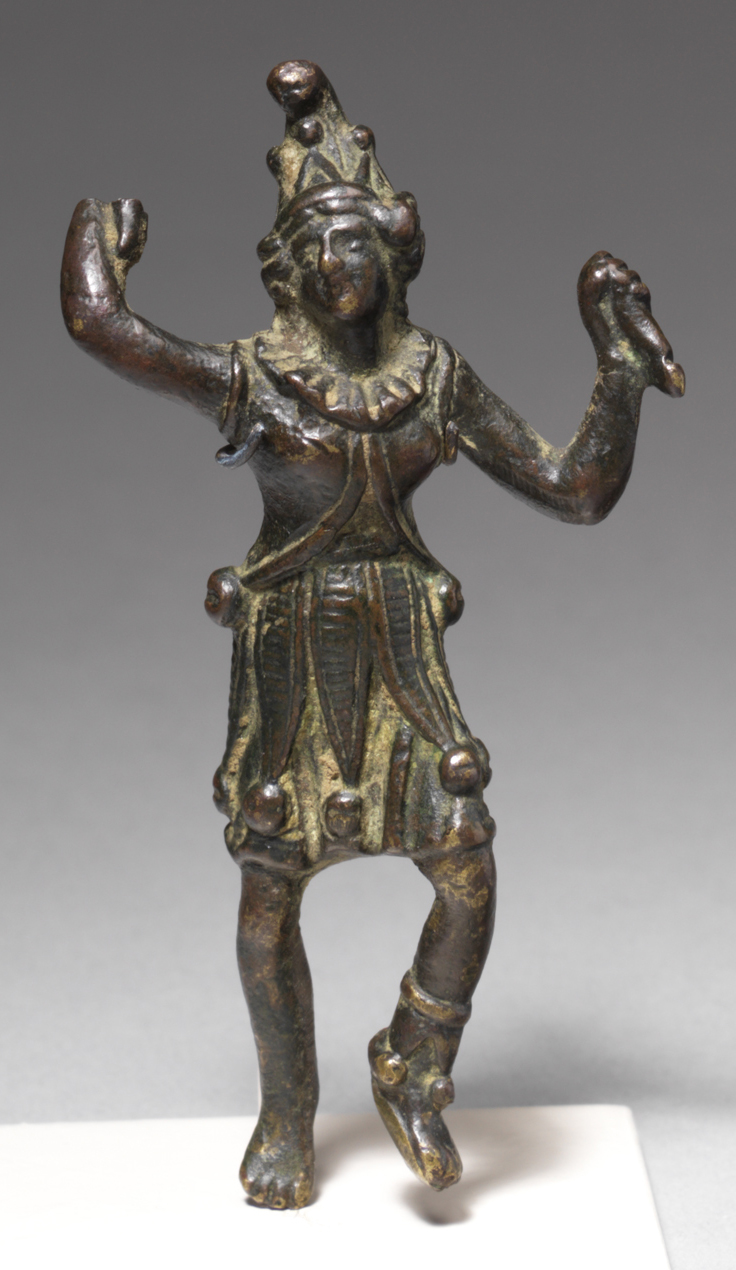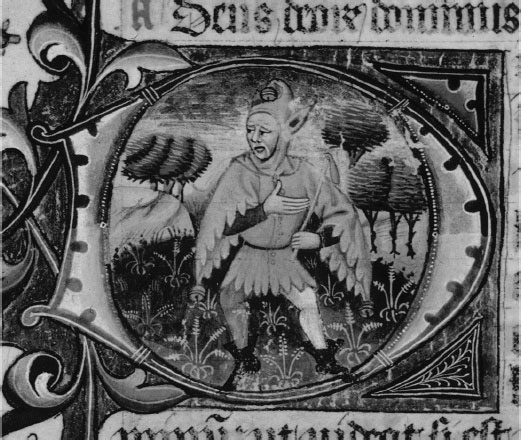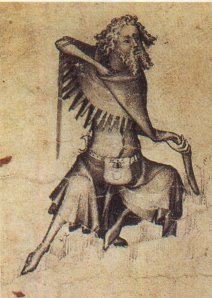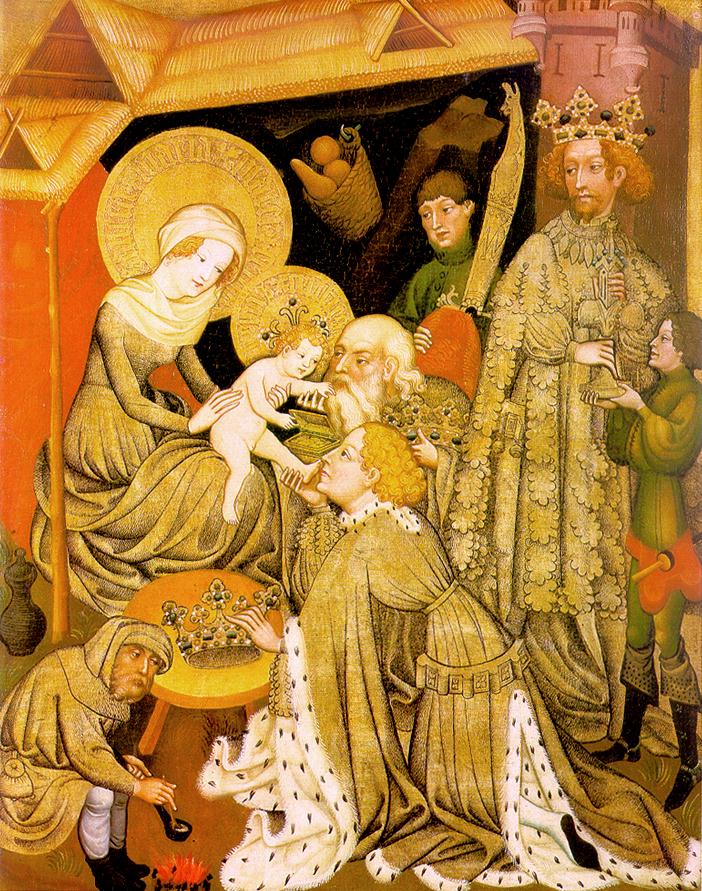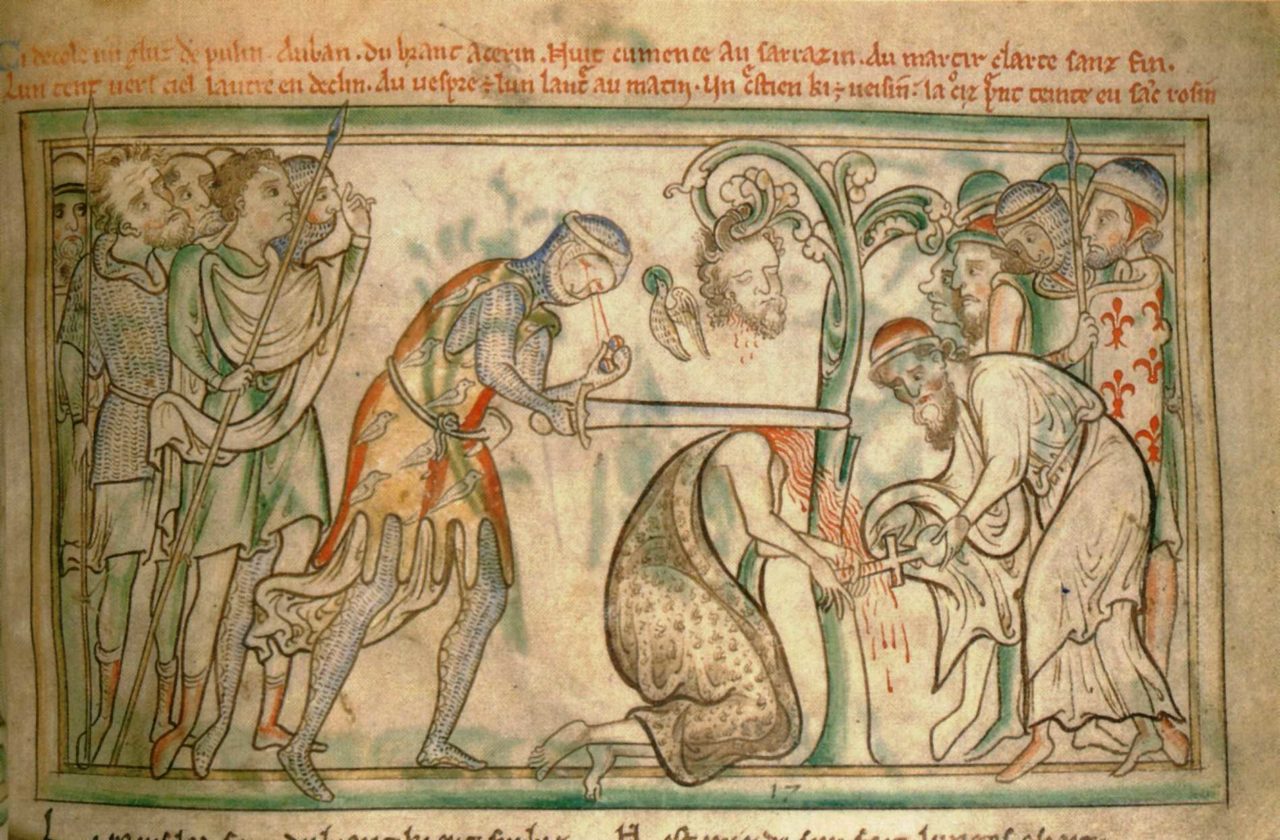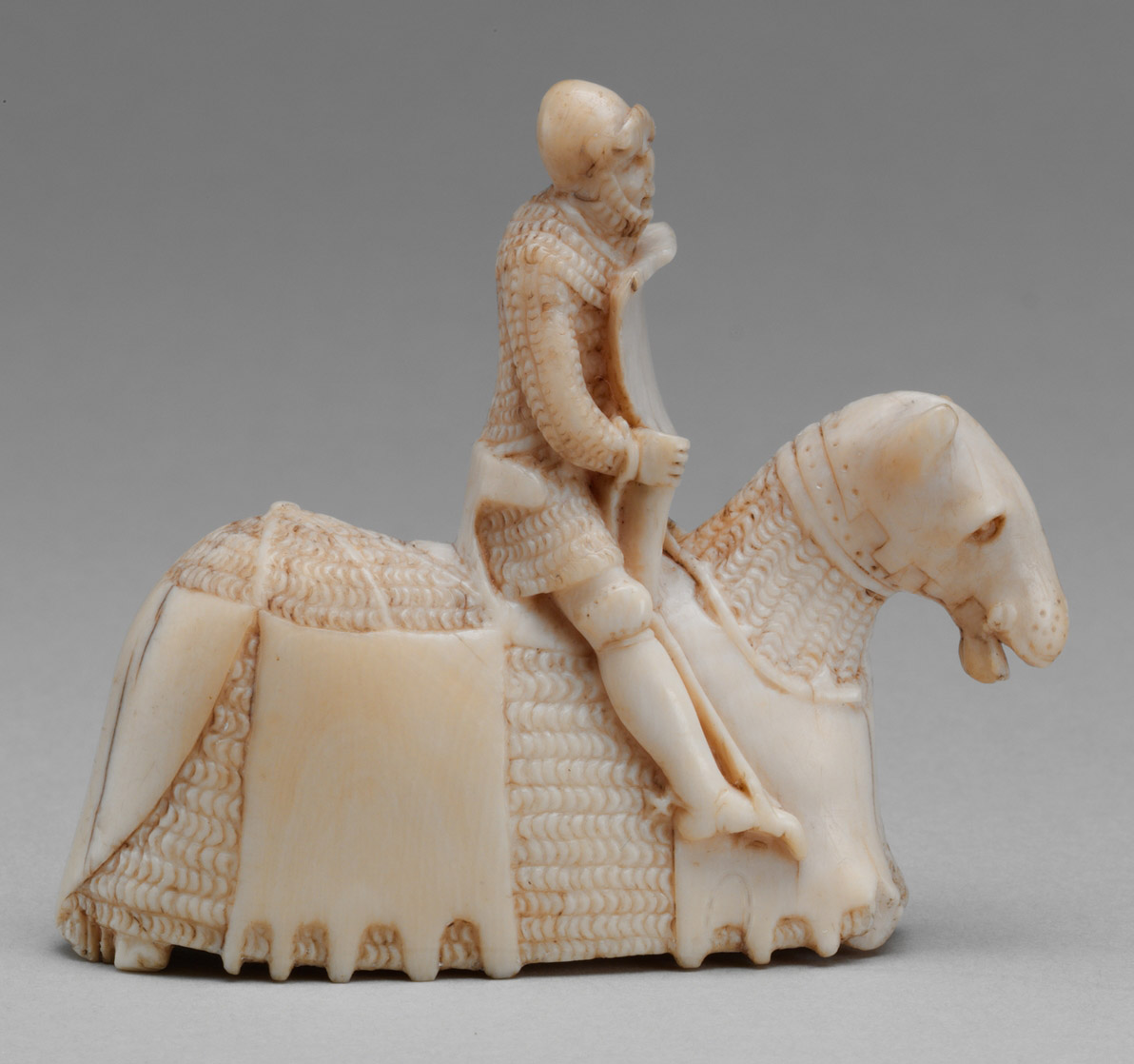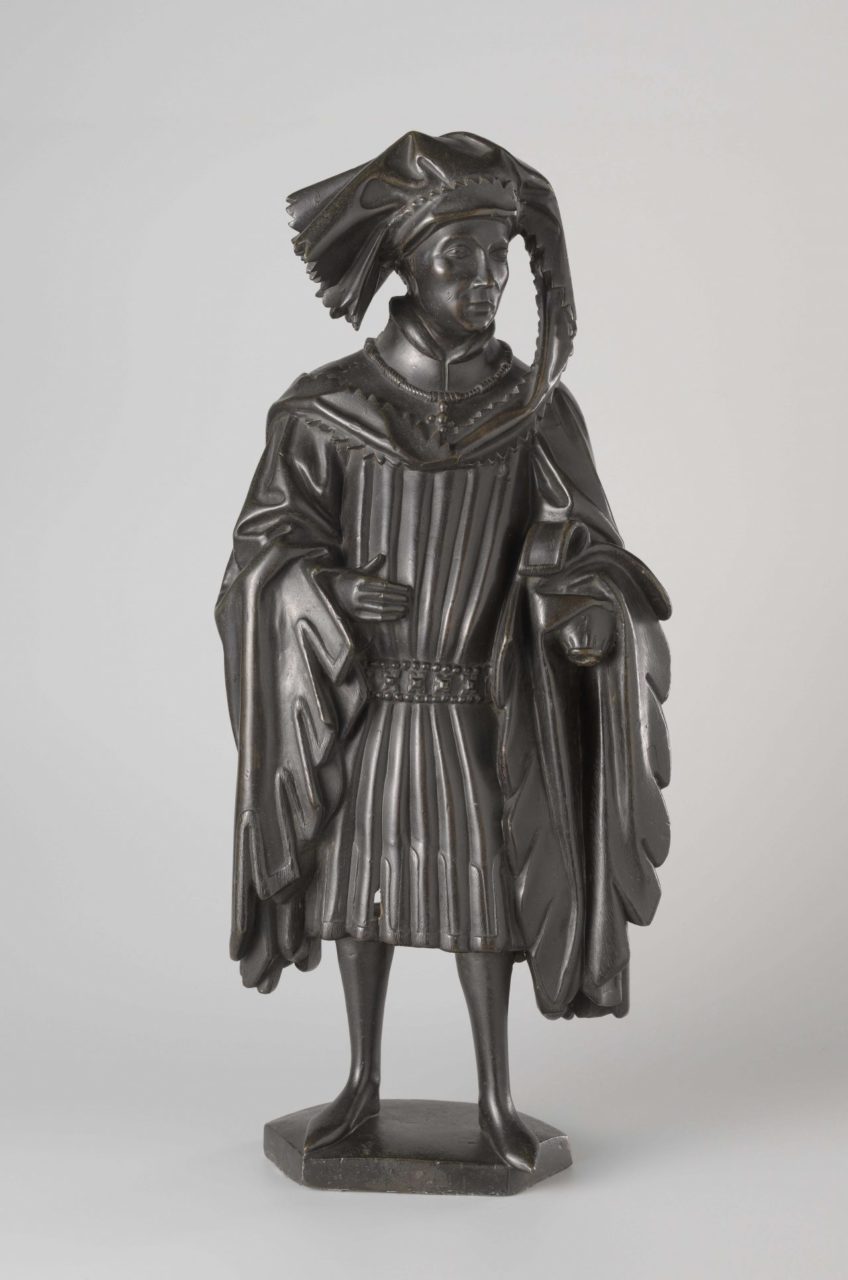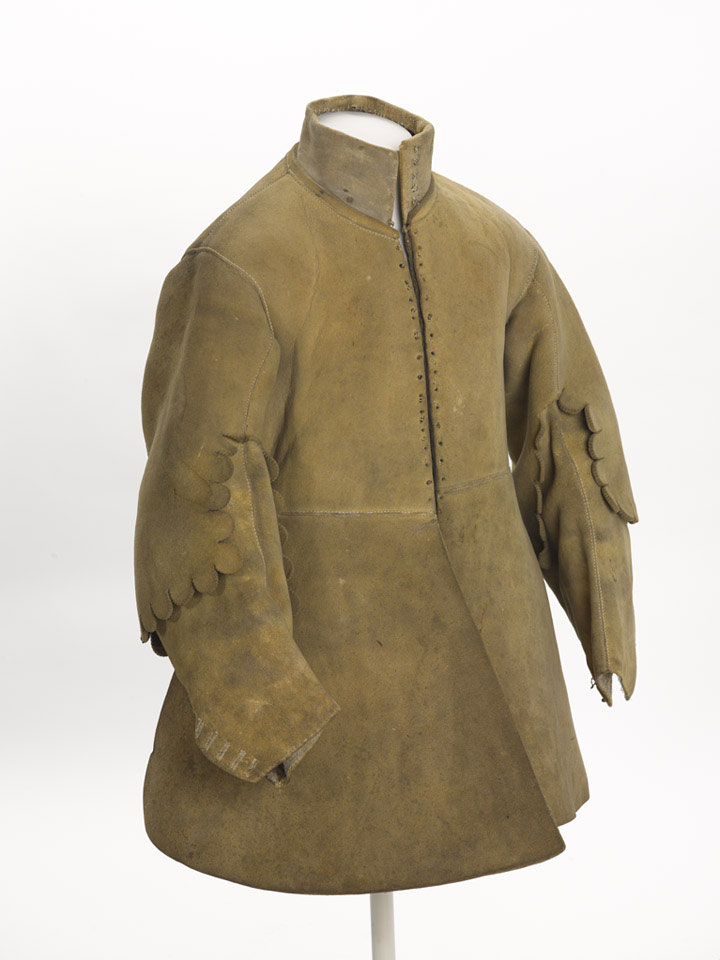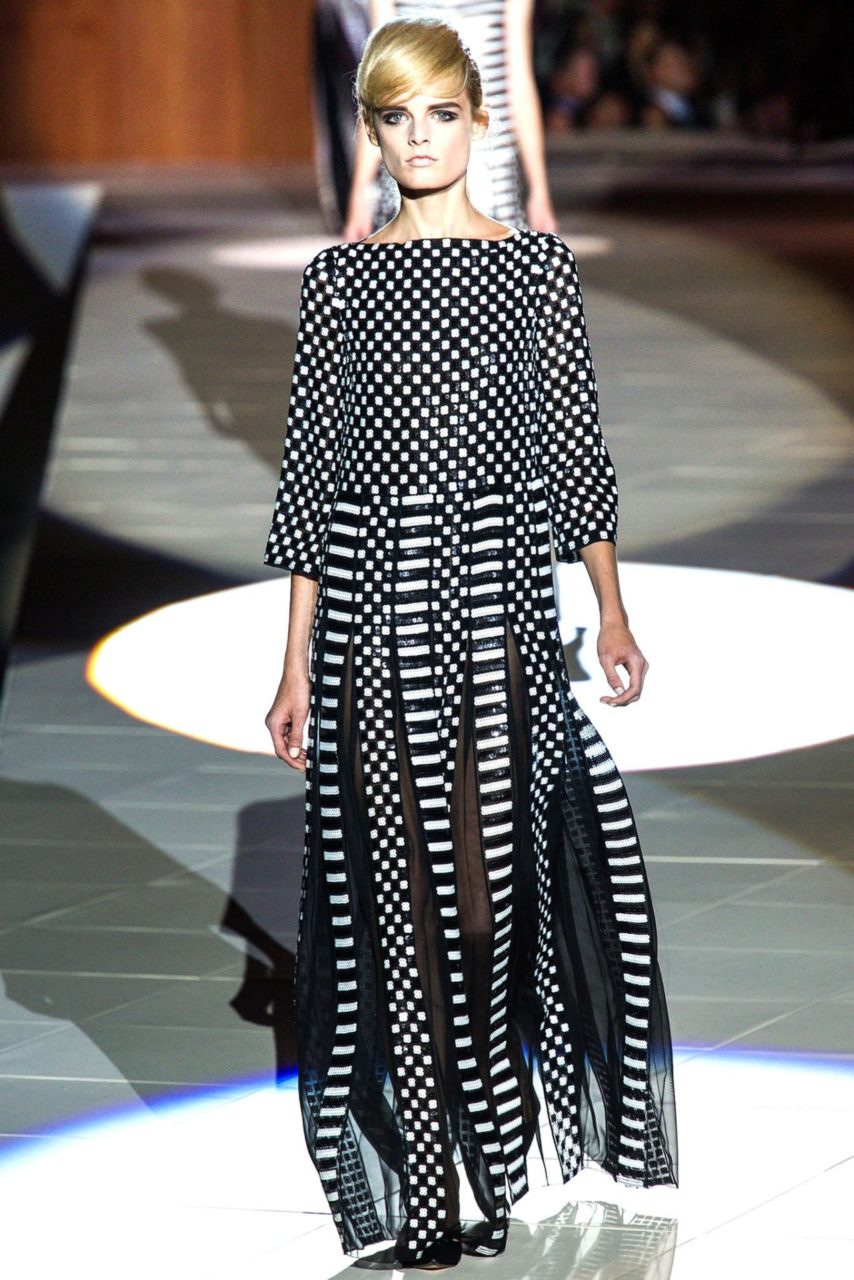An extremely popular decorative edging technique created by cutting that reached its height during the Middle Ages and Renaissance.
The Details
Dagging (also “daggings”, “dagges”; adjective: “dagged”) is a decorative element added to the edges of garments and objects. It is created by cutting or slashing the fabric into different shapes, some simple, some elaborate. A few scholars argue that dagging appeared as early as 200 CE, as seen in the bronze statuette in figure 1 (Friedman 122). The weight of opinion, however, places dagging in the Middle Ages and Renaissance, the broadest chronological range being from the 13th to the 16th century. This treatment, found everywhere on clothing in England and Western Europe, “illustrated the growing importance of intricate, unique details in fashion in the Renaissance” (Encyclopedia of Fashion).
The Technique of Dagging
Dagging is created by cutting or slashing the edges of fabric with shears or scissors. It also can be created by sewing pieces of fabric to the edges of fabric in the manner of an appliqué (Friedman 123). Changes in the way textiles were made are believed to have played a role in the emergence of dagging. Woven textiles, especially wool, were produced with dense edges that made it possible to cut shapes into the edges without the cloth raveling (Brown 72).
The process of fulling, which produces a stronger cloth, also contributed (Friedman 123). As explained in Elisabeth Crowfoot’s Textiles and Clothing c. 1150-1450:
“Since medieval cloth was often well fulled, indeed deliberately heavily fulled to exclude rain, cut edges could be left without protective over-stitching or binding. Thus grew up the practice of cutting cloth into shapes as ornamental edges or applications.” (194)
The materials to which dagging was applied included wool, silk, fur, contrasting fabrics, and leather trim (Tortora 156).
The Varied Forms of Dagging
Dagging could be basic: Simple cuts in V and U shapes (Figs. 2 & 5) or strips (Fig. 3). But it provided a broad canvas to the skilled artisan, who transformed the garment edges into a complex variety of shapes:
“It could be a zigzag design, crenelation (like the parapet at the top of a tower), scalloping, or foliation (in the shape of leaves). Some people looked as if they were trailing a branch of an oak tree or bunches of spinach behind them. Long strips of fur or fabric dangled from sleeves and the tips of hoods.” (Payne 192)
Examples of intricate cut work are seen in the early 15th century painting The Adoration of the Magi (Fig. 4) and Jan van Eyck’s Arnolfini Wedding Portrait (Fig. 6), which was painted about 15 years later.
Fig. 1 - Artist unknown (Roman). Mime dancer, late 2nd century AD. Bronze; 7.5 x 4.2 x 2.0 cm (2 15/16 x 1 5/8 x 13/16 in). Princeton University Art Museum: Princeton, y1956-101. Bequest of Professor Albert Mathias Friend, Jr., Class of 1915. Source: PUAM
Fig. 2 - Artist unknown (English). Fool in dagged costume, from an English psalter illuminated by the Wingfield Master, ca. 1460. Source: Medieval Clothing and Textiles
Fig. 3 - Artist unknown (French). A Messenger retrieving a letter from his hood, ca. 1400. Pen and ink drawing. Berlin: Staatliche Museen Preussischer Kulturbesitz, Kupferstichkabinett. Source: Muckley
Fig. 4 - Artist unknown (German, active in 1420s in the Middle Rhineland). The Adoration of the Magi, ca. 1420. Tempera on pine; 100 x 81 cm. Darmstadt: Hessisches Landesmuseum. Source: Web Gallery of Art
Fig. 5 - Matthew Paris. The martyrdom of St. Alban, from a 13th century manuscript of The Life of St. Alban. Dublin: Trinity College Library, MS E. I. 40, folio 38r. Source: Wikimedia
Fig. 6 - Jan van Eyck (Netherlandish, 1390-1441). Detail of Portrait of Giovanni Arnolfini and his Wife, 1434. Oil on oak panel; 82.2 x 60 cm (32.3 x 23.6 in). London: National Gallery, NG186. Source: National Gallery
Fig. 7 - Artist unknown (Western European, possibly England). Chess Piece in the Form of a Knight, ca. 1350-60 CE. Ivory; 6.1 x 6.4 x 1.6 cm. New York: Metropolitan Museum of Art, 68.95. Pfeiffer Fund, 1968. Source: Metropolitan Museum of Art
Fig. 8 - Attributed to Renier van Thienen. Ten weepers from the tomb of Isabella of Bourbon, ca. 1475 - 1476. Brass copper alloy; 55.5 × 25.5 × 12.5 cm. Amsterdam: Rijksmuseum. On loan from the City of Amsterdam. Source: Rijksmuseum
Fig. 9 - Jacques de Longuyon (Belgian). Vows of the Peacock, ca. 1345–50. Illuminated manuscript; 24.5 x 17.5 cm. New York: Morgan Library, MS G.24, fols. 25v–26r. Gift of the Trustees of the William S. Glazier Collection, 1984. Source: The Morgan
In the Adoration, the standing Magi figure at the right wears a robe whose neckline appears to be ringed with bay-leaf shaped dagging appliqués caught under the neck binding. The shoulders and the pleats of his coat are covered with other foliated shapes. The sleeves of the wife’s gown in The Arnolfini Wedding Portrait “are elaborately bordered with a type of pieced, slashed-and-stitched pattern, a form of dagging (appliqué of petal-shaped pieces of material)” (Rosenbaum).
Although not discussed in the sources, based on the evidence in art works, it appears that the clothing of wealthier people had more detailed dagging work. It would make sense in that the rich had access to artisans not available to the poor. The Arnolfini Portrait is often viewed as a document attesting to the wealth of the subjects — the husband was a successful merchant — in part by displaying their expensive, beautiful garments (Rosenbaum). It is revealing that of the many embellishment techniques available, dagging was one that was chosen.
Garments to which Dagging was Applied
Medieval and Renaissance people applied dagging to virtually every outer garment, including “sleeves, tippets, collars, hemlines, cloaks, and hoods were flamboyantly edged with dagging (also dagges), a scalloped or crenelated cut” (Hill 332). It was applied “on common garments of the day to add decoration in accordance with fashion trends” (Encyclopedia of Fashion). “In this way [dagging was] related to similar fashion trends throughout history, such as the use of clavi, or stripes on Roman togas and tunicas or the use of fringe on shirts in the twentieth century” (ibid). Dagging also made an appearance on objects other than clothing, such as the caparison of a horse. One is depicted in an ivory knight chess piece in the collection of The Metropolitan Museum of Art (Fig. 7).
Who Wore Clothes Decorated with Dagging
Scholars agree that people of all stations of life throughout England and Western Europe wore dagged garments. The embellishment is seen on the sleeves and hood of the aristocratic mourner in the sculpture series the Ten Weepers from the Tomb of Isabella of Bourbon (Fig. 8), as well as on ordinary lower class individuals such as a messenger (Fig. 3), or an executioner (Fig. 5). As Hill notes, “this decorative treatment was not solely confined to the garments of the wealthy. Illuminated manuscripts show grooms, servants, even field workers and shepherds wearing clothing accented with dagging” (332).
There is some disagreement about whether people of every class wore dagged clothes during the same time periods. John Block Friedman argues that the trend originated with “marginalized groups like mimes and entertainers,” worked its way up to the royalty, and filtered down to the aristocracy, finally being adopted by the lower classes, just as it was becoming outmoded among the higher classes (Friedman 131, 134, 138).
Negative Perception by Some Contemporary Writers
Dagging was not without controversy. To some contemporary observers, the technique was no benign aesthetic flourish, rather, it connoted a lack of seriousness or worse:
“Moralist writers of the period, such as William Langland in Piers Plowman around 1378 associated dagging with frivolity when he spoke of those who ‘loved worldliness and ordered dagged clothes’.” (Tortora 156)
The Vows of the Peacock (Fig. 9) depicts a fun-loving set of characters–two wearing dagged chaperones–of whom Langland would doubtless disapprove. In Chaucer’s “The Parson’s Tale,” the eponymous cleric is concerned that if the poor emulated the form of dress of the rich, societal order would be disrupted (Friedman 125-26). In sum, notes Friedman:
“[D]agging was singled out … to signal a wide variety of vices or unacceptable social behaviors such as vanity; worldliness; sexuality; pagan, Eastern, and Saracenic brutality, particularly toward Christians; and human folly.” (Friedman 132)
Its Afterlife
Revivals of Dagging Since the Renaissance
Although the Middle Ages and early Renaissance were without doubt the high-water mark of dagging, small waves followed in subsequent eras. An early 17th-century example is a buff coat worn by Major Thomas Sanders, a Parliamentarian officer during the First English Civil War (1642-1646) (Fig. 10).
After 1814, when Napoleon lost control of the Empire, France looked back to an idealized past and embraced romantic expressions in dress reflecting it, including the troubadour style, which used dagging (Chrisman-Campbell). The historical romance works of Victor Hugo and Sir Walter Scott, sometimes set in medieval times, also piqued a new interest in dagging (Ribeiro; Hill 462). At this point and thereafter, dagging appears to have been limited to women’s clothing.
Since at least the 20th century, dagging has been a popular element in theatrical costumes seeking to evoke a fanciful or imaginary past. In the post-World War II era, perhaps related to the adventurous mood overtaking women’s fashion at the time, and in parallel with silhouette developments like the New Look, dagging can be seen on 1950s gowns. In the 1970s, it was employed by English designer Zandra Rhodes, who looks frequently to medieval garments for inspiration (Fig. 11). Finally, in 2013, American designer Marc Jacobs as part of his Spring ready-to-wear collection presented pieces with scalloped and striped edges that strongly evoked dagging, as well as other medieval design elements such as particolor (Figs. 12-13).
Fig. 10 - Maker unknown (English). Buff coat worn by Major Thomas Sanders, ca. 1640. Leather. London: National Army Museum, NAM. 1972-09-49-1. Source: National Army Museum
Fig. 12 - Marc Jacobs (American, 1963-). Ready-To-Wear, Spring 2013. Source: Vogue
Fig. 11 - Zandra Rhodes (English, 1940-). Chiffon gown with dagged strips, 1970. Source: Christie's
Fig. 13 - Marc Jacobs (American, 1963-). Ready-To-Wear, Spring 2013. Source: Vogue
References:
- Boucher, François. 20,000 Years of Fashion: The History of Costume and Personal Adornment. Expanded ed. New York: H.N. Abrams, 1987. http://www.worldcat.org/oclc/979316852.
- Brown, Susan, ed. Fashion: The Definitive History of Costume and Style. New York: DK Publishing, 2012. http://www.worldcat.org/oclc/840417029.
- Calasibetta, Charlotte Mankey, Phyllis G. Tortora, Charlotte Mankey Calasibetta, and Publications Fairchild. The Fairchild Dictionary of Fashion. 3rd ed. New York: Fairchild Publications, 2003. http://www.worldcat.org/oclc/959132362.
- Chrisman-Campbell, Kimberly. “France.” The Berg Fashion Library. Accessed Feb. 12, 2016. (subscription required)
- Crowfoot, Elisabeth, Frances Pritchard, and Kay Staniland. Textiles and Clothing: C.1150-c.1450. Medieval Finds from Excavations in London 4. London: HMSO, 1992. http://www.worldcat.org/oclc/869768478.
- “Dagging and Slashing – Fashion, Costume, and Culture: Clothing, Headwear, Body Decorations, and Footwear through the Ages.” Accessed August 13, 2018. http://www.fashionencyclopedia.com/fashion_costume_culture/European-Culture-15th-Century/Dagging-and-Slashing.html.
- Friedman, John Block. “The Iconography of Dagged Clothing and Its Reception by Moralist Writers.” In Medieval Clothing and Textiles 9, ed. Robin Netherton and Gale R. Owen-Crocker (Woodbridge, Suffolk: Boydell and Brewer, 2013): 121-138. www.academia.edu. Accessed February 18, 2016.
- Hill, Daniel Delis. History of World Costume and Fashion. Upper Saddle River, NJ: Pearson Prentice Hall, 2011. http://www.worldcat.org/oclc/768100950.
- Lewandowski, Elizabeth J. The Complete Costume Dictionary. Lanham, MD: Scarecrow Press, 2011. http://www.worldcat.org/oclc/788995672.
- Payne, Blanche, Geitel Winakor, and Jane Farrell-Beck. The History of Costume: From Ancient Mesopotamia through the Twentieth Century. 2nd ed. New York: HarperCollins, 1992. http://www.worldcat.org/oclc/659908345.
- Ribero, Aileen, et al. “Dress.” Grove Art Online. Oxford Art Online. Oxford University Press. Accessed March 9, 2016. (subscription required)
- Rosenbaum, Sandra, “Dress and Art: Western.” The Berg Fashion Library. Accessed Feb. 12, 2016. (subscription required)
- Tortora, Phyllis G., and Sara B. Marcketti. Survey of Historic Costume. Sixth edition. New York: Fairchild Books, 2015. http://www.worldcat.org/oclc/972500782.

